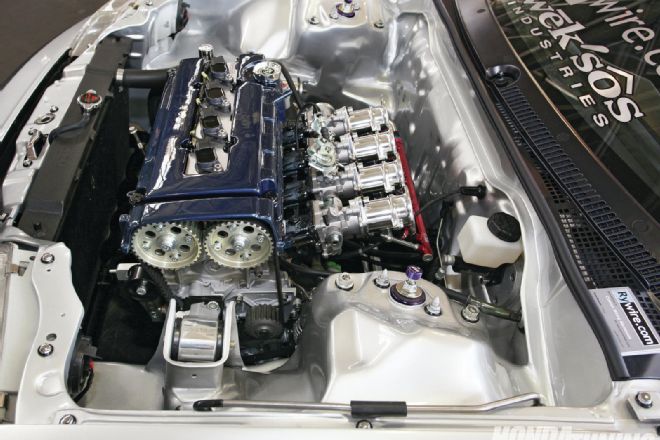Though you might not give much thought to your Honda’s ignition system, the fact is, it’s a very important and often overlooked area of performance. In this article I’ll be going over the basics of the system and highlighting the components that are crucial in high-horsepower applications. When most people think about their car’s ignition system, they tend to focus on the spark plugs, spark plug wires, and distributor. With OEM systems, these three components need nothing more than proper maintenance, and of course, replacements when they wear out. On high-performance turbo and naturally aspirated applications these components are typically replaced altogether. Using an internal coil distributor on your build can actually cost you precious efficiency and induce a loss of power across the entire powerband. Even OEM manufacturers over the years have made significant changes and moved to more efficient components.
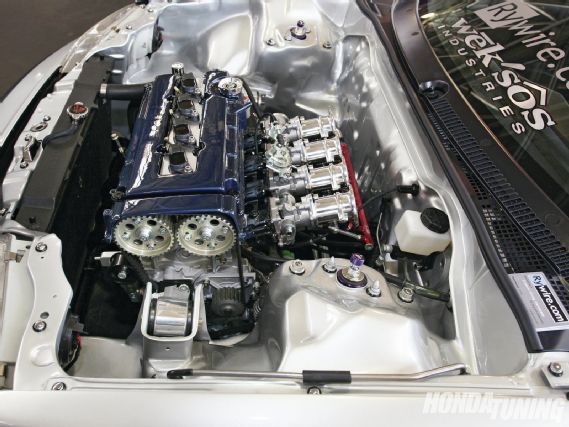 |
Both B-series VTEC engines shown here have been upgraded with a Rywire.com C.O.P. conversion kit. Beyond the modern aesthetics, this system’s attributes include improvements in spark and reliability, as well as leaving plenty of room to add a lot more power in the future.
|
Both B-series VTEC engines shown here have been upgraded with a Rywire.com C.O.P. conversion kit. Beyond the modern aesthetics, this system’s attributes include improvements in spark and reliability, as well as leaving plenty of room to add a lot more power in the future.
In the mid-’90’s, Honda began placing the coil outside of the distributor; a technique that produces greater spark efficiency for their larger-displacement engines. This elevated level of efficiency in turn lowered operating temperatures and increased fuel economy with a better, cleaner spark. The larger coil allowed for better recovery after the coil was discharged, resulting in a steady and consistent spark on high-revving applications; something internal coils struggle with. Soon after, Honda released a much more modern, coil-on-plug application, or C.O.P. This change from a single coil to four independently placed coils directly on top of each spark plug was a huge upgrade for the ignition system. Increased reliability, fuel economy, power, and even fewer emissions were the result. In recent years, Honda performance builders have been searching for ways to add multiple coils to their non-C.O.P. equipped engines, like the B-series.
The primary component in the C.O.P. system is the coil itself. On older engines like the B-series, it’s become common to see coils added for a stronger spark, and the elimination of dwell time. There are two styles of commonly used coils; three-wire (smart) coils, and two-wire (dumb) coils. Smart coils, with the igniter built-in, don’t need a control box to operate. They have their own power, ground, and signal wire for the igniter. This setup is excellent for mid-range horsepower and is a worthwhile upgrade to any moderate horsepower application as well. Smart coils do offer some room for future upgrades, as they’ll support motors making as much as 600 hp. In my opinion, this route is the best direction to take for any street/weekend race car. Its relatively low cost combined with its amazing performance is the best bang for the buck mod available for your ignition system. When dealing with a B-series engine, K-series coils are a great choice, as they can be wired in easily, and will produce a smooth idle and great spark throughout the powerband.
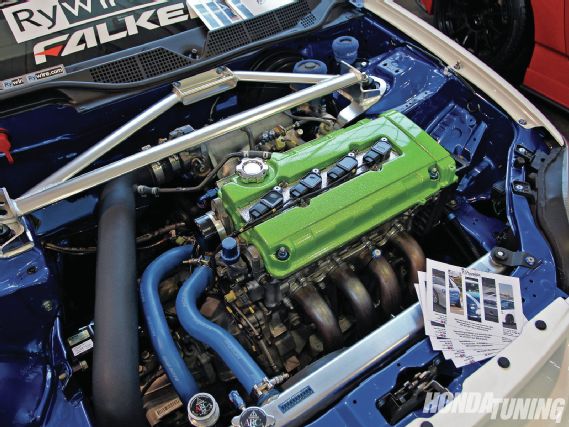 |
Both B-series VTEC engines shown here have been upgraded with a Rywire.com C.O.P. conversion kit. Beyond the modern aesthetics, this system’s attributes include improvements in spark and reliability, as well as leaving plenty of room to add a lot more power in the future.
|
Both B-series VTEC engines shown here have been upgraded with a Rywire.com C.O.P. conversion kit. Beyond the modern aesthetics, this system’s attributes include improvements in spark and reliability, as well as leaving plenty of room to add a lot more power in the future.
The next step up would be a full CDI (capacitor discharge ignition) ignition system. This system uses two-wire coils and a CDI ignition amplifier box, and is a little more complex as it requires a bit more hardware and electrical for operation. Utilizing a CDI box, this system can support mild builds all the way up to ultra-competitive (think 1,000+ hp) monsters. It’s another very popular direction I see people taking, and for good reason. The flexibility in this system allows for almost unlimited growth. If you’re starting off with a low-boost setup with visions of later moving on to a high-boost race car, a proper two-wire coil system is key. The most commonly used units these days are the M&W Pro 14 and the AEM Twin-Fire units. Both applications are proven to make big numbers, and are used on the fastest B-series Hondas today. I would recommend using your horsepower goals to be the deciding factor on which coil system you go with.
AEM recently released an inline four-channel coil driver that allows you to use two-wire coils with no large (and often costly) CDI driver box. This low-cost piece can be wired inline making it a quick and easy hookup for C.O.P. conversions. Utilizing this method is a simple solution to allow you to use the two-wire coils without a CDI, however, it’s limited because it still falls under the medium horsepower application range.
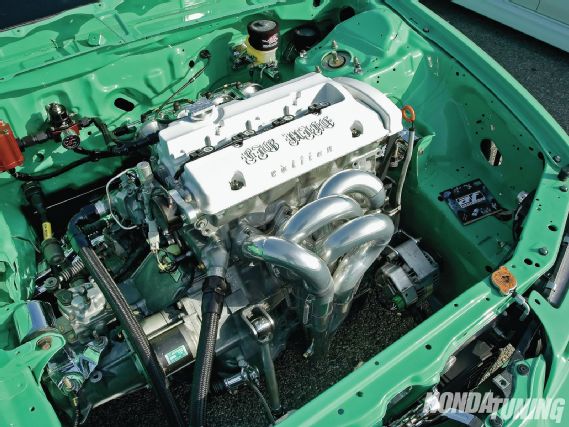 |
Big Mike’s F20B Prelude utilizes a set of AEM pencil coils controlled by AEM’s Twin Fire CDI ignition box. This setup works great with his current Kinsler ITB setup, and is capable of supporting some serious horsepower numbers should Mike choose to go bigger with his horsepower goals.
|
Big Mike’s F20B Prelude utilizes a set of AEM pencil coils controlled by AEM’s Twin Fire CDI ignition box. This setup works great with his current Kinsler ITB setup, and is capable of supporting some serious horsepower numbers should Mike choose to go bigger with his horsepower goals.
The next part of the C.O.P. modification is the Engine Control Unit, or ECU. This part of the conversion is the most important, most costly, and possibly the most beneficial. The ECU must be able to control at least four separate coil channels independently. Most stand-alone management systems should have this capability, but it is always a good idea to verify before purchasing. Choosing a proper management system can be confusing, and I suggest asking your tuner what system they are comfortable with before moving forward. Personally, I use the AEM EMS Series 2 system. The EMS is relatively easy to use and tune, and is competitively priced, especially when you consider the strength of the system. The name Motec, commonly tossed around when referring to that infamous, humorous, high-dollar motion picture, is not actually an exhaust system, contrary to Hollywood writers’ beliefs. In actuality, it’s a very complex and absolutely amazing stand-alone management system used in some of the world’s fastest and most competitive cars, trucks, and boats. A Motec management system would be the ultimate system to use for the hard-core competitor, but you will have to pay for all of that technology. Whatever management system you choose, make sure it fits your budget, meets or exceeds your horsepower goals, and has room for growth.
Another important component of the C.O.P. conversion is the trigger system for the cam and crankshaft pickup. This is a magnetic Hall effect sensor that tells the ECU exactly where the components are in their respective rotation. T1 Race Development and AEM Electronics both have their own magnetic Hall effect sensor pickups. T1’s is commonly referred to as the T1 cam trigger, while the AEM unit is called the Engine Position Module, or EPM. Most aftermarket ECUs read much more precisely when using a Hall effect sensor over the OEM magnet units. Both are excellent choices, and both are simple four-wire hookups. I’ve used both the T1 and AEM systems with excellent results!
The next important (and again, often overlooked) part of the ignition system is the spark plug itself. Generally speaking, the higher the heat range, the more power the spark plug is rated for (within reason). Heat ranges in the 8s and 9s are commonly used on high-horsepower and turbo applications. When using a CBR coil, one thing to note is that you need to use a spark plug with a threaded tip. Denso has a line of spark plugs suited specifically for this type of application. AEM on the other hand has designed their tip to fit common spark plugs with press-on tops. Choosing the proper plug can take some time, so ask your tuner what he recommends for your horsepower goals and application.
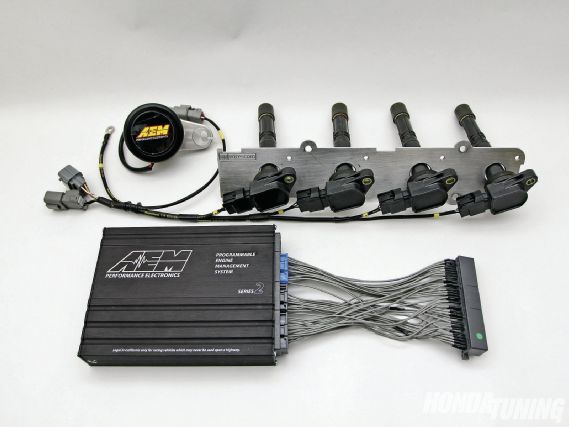 |
Rywire.com offers a complete C.O.P. conversion kit that incorporates OEM K-series coils with a custom plate cover, AEM 30-6050 EMS, and AEM position module.
|
Rywire.com offers a complete C.O.P. conversion kit that incorporates OEM K-series coils with a custom plate cover, AEM 30-6050 EMS, and AEM position module.
Last but not least, and my personal favorite, is the wiring itself. I have come up with a revolutionary product that makes the C.O.P. conversion a plug-and-play affair. My kit uses an AEM EMS series 2 ECU, AEM EPM trigger, and my new adapter plate that allows you to bolt the K-series coils to the B-series valve cover. The last part of the kit is a custom distributor jumper harness that plugs directly into the OEM distributor plug and runs to all four coils and EPM. For the ECU side, a modified ECU jumper harness is used to convert the ECU plugs and coil functions.
Adding coils on your B-, H-, or D-series engine is the ultimate upgrade for the modern look, feel, and most importantly, performance of your older engine. With all the technology being made to the internals of the B-series engine, we have too long overlooked the ignition and management systems. It’s time to turn our focus back to the basics and realize just how amazing modern technology really is!

